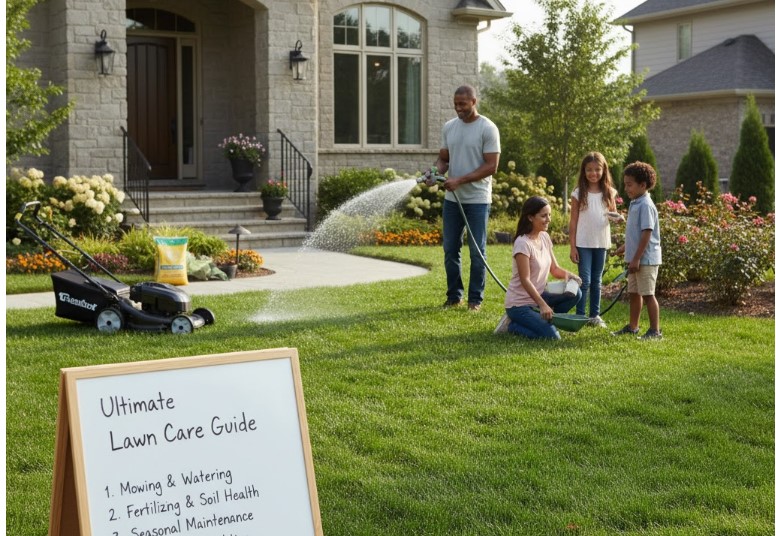A lush, green, and well-maintained lawn is the pride of every homeowner. It enhances the beauty of your property, increases curb appeal, and creates a relaxing outdoor space for family and friends. But achieving that perfect yard requires more than just occasional mowing. From soil care to seasonal maintenance and professional landscaping, every detail counts.
In this comprehensive guide, you’ll learn how to care for your lawn effectively—covering everything from mowing and watering to fertilizing and lighting. Whether you’re a homeowner or a property manager, these expert tips will help you keep your yard vibrant and healthy all year long.
Understanding the Basics of Lawn Care
Before you grab your lawnmower, it’s important to understand what your lawn really needs. Every yard is different—factors such as soil type, grass species, sunlight, and climate determine the care it requires.
Know Your Grass Type
Different grass varieties thrive in different regions. For example, warm-season grasses like Bermuda and Zoysia are perfect for southern climates, while cool-season grasses such as Fescue and Kentucky Bluegrass grow best in northern areas. Identifying your grass type helps you tailor your watering, mowing, and fertilizing schedule effectively.
Test Your Soil
Healthy soil means a healthy lawn. Conduct a soil test at least once a year to check pH levels and nutrient content. Ideally, your soil should have a pH between 6.0 and 7.0. If your soil is too acidic, adding lime can balance it; if it’s too alkaline, sulfur can help correct it.
Proper Mowing Techniques for a Healthier Lawn
Mowing seems simple, but doing it the wrong way can weaken your grass and promote weed growth.
Don’t Cut Too Short
Never remove more than one-third of the grass blade at a time. Cutting too short (scalping) stresses the grass, making it vulnerable to pests and diseases. Keep your mower blades sharp to ensure a clean cut.
Follow the One-Third Rule
If your grass is 3 inches tall, don’t cut it shorter than 2 inches. Taller grass shades the soil, keeping it cool and reducing water evaporation.
Mow in Different Directions
Vary your mowing pattern each week to avoid compacting the soil and creating ruts. This helps the grass grow upright and evenly.
Watering Wisely – The Key to a Greener Lawn
Water is essential for grass health, but timing and quantity matter.
Water Deeply, Not Frequently
Instead of shallow daily watering, give your lawn a deep soak two to three times per week. This encourages deeper root growth and makes your grass more drought-resistant.
Early Morning is Best
Water your lawn between 6 a.m. and 10 a.m. to reduce evaporation and allow the grass to dry before nightfall, preventing fungal diseases.
Adjust for Weather
Use a rain gauge or smart irrigation system to avoid overwatering. Your lawn typically needs about one inch of water per week, including rainfall.
Fertilizing for Stronger, Greener Growth
Fertilizers replenish the essential nutrients that grass needs to grow thick and vibrant.
Choose the Right Fertilizer
A balanced fertilizer with nitrogen (N), phosphorus (P), and potassium (K) supports overall growth. Slow-release fertilizers provide steady nutrition and reduce the risk of burning your lawn.
Seasonal Fertilizing Schedule
- Spring: Apply a nitrogen-rich fertilizer to boost growth.
- Summer: Use a balanced mix to maintain color and density.
- Fall: Apply potassium-heavy fertilizer to strengthen roots for winter.
Don’t Overdo It
More fertilizer doesn’t mean faster growth. Over-fertilizing can lead to thatch buildup, nutrient runoff, and even lawn burn.
Weed, Pest, and Disease Control
A well-cared-for lawn naturally resists weeds and pests, but preventive care is still important.
Preventing Weeds
Apply pre-emergent herbicides in early spring to stop weed seeds from germinating. Regular mowing and proper fertilization also reduce weed invasion.
Managing Lawn Pests
Common pests like grubs, chinch bugs, and armyworms can damage roots and grass blades. Use organic insecticides or contact a professional lawn care service for safe treatment.
Fighting Lawn Diseases
Fungal issues such as brown patch or dollar spot often arise from excess moisture. Proper watering and aeration help prevent these diseases naturally.
Seasonal Lawn Maintenance Checklist
Each season brings unique lawn care challenges. Following a consistent year-round routine keeps your yard in top shape.
Spring
- Aerate compacted soil.
- Reseed bare patches.
- Apply pre-emergent weed control.
- Start regular mowing.
Summer
- Maintain deep watering schedule.
- Sharpen mower blades.
- Watch for pests and treat early.
Fall
- Fertilize to strengthen roots.
- Rake leaves regularly.
- Overseed to fill thin areas.
Winter
- Limit foot traffic on frozen grass.
- Remove debris.
- Prepare tools and equipment for spring.
The Role of Professional Landscaping Services
While regular care keeps your lawn healthy, professional help can elevate it to the next level. Landscaping experts design, maintain, and enhance your yard’s beauty with precision and experience.
Why Hire a Professional?
Professionals understand local soil conditions, grass types, and weather patterns. They use high-quality equipment and eco-friendly products, ensuring your lawn stays healthy and green all year round.
Spotlight on Greener Grass Landscaping
For homeowners and businesses in Mount Pleasant, South Carolina, one of the most trusted names in lawn care is Greener Grass Landscaping.
They specialize in:
- Lawn maintenance and mowing
- Palm tree trimming
- Fertilizing and weed control
- Landscape lighting
Whether you want to refresh your lawn, install new lighting, or schedule regular maintenance, Greener Grass Landscaping provides reliable, affordable, and high-quality services that transform any outdoor space.
Eco-Friendly Lawn Care Practices
Modern lawn care isn’t just about aesthetics—it’s about sustainability.
Compost and Organic Fertilizers
Use compost or natural fertilizers to enrich your soil without chemicals. They improve soil texture and promote healthy microbial activity.
Smart Irrigation
Install drip systems or smart sprinklers to save water while keeping your lawn hydrated.
Native Plants and Landscaping
Incorporate native grasses and plants—they require less maintenance and are better suited to your region’s climate.
Landscape Lighting – The Final Touch
Good lighting can completely transform your outdoor space. It highlights pathways, enhances safety, and adds a warm, inviting glow to your garden.
Types of Landscape Lighting
- Pathway lights: Illuminate walkways and driveways.
- Spotlights: Highlight trees or garden features.
- Accent lighting: Adds depth and ambiance.
Professionals like Greener Grass Landscaping can design lighting that not only beautifies your space but also saves energy through efficient LED systems.
Common Mistakes to Avoid in Lawn Care
Even with good intentions, many homeowners make small mistakes that harm their lawns.
Overwatering
Too much water can drown roots and cause fungus.
Ignoring Soil Health
If you focus only on mowing and watering without testing soil, your lawn will eventually suffer nutrient deficiencies.
Using the Wrong Fertilizer
Not all fertilizers are equal. Using the wrong mix can lead to patchy or burnt areas.
Final Thoughts
A beautiful yard doesn’t happen overnight—it’s the result of consistent care, proper techniques, and sometimes a helping hand from professionals. Whether you’re trimming, watering, or fertilizing, every step contributes to creating a vibrant, healthy, and inviting outdoor environment.
If you want expert help with lawn maintenance, palm tree trimming, or landscape lighting in Mount Pleasant or Sullivan’s Island, SC, reach out to Greener Grass Landscaping. Their team of professionals is dedicated to delivering stunning results tailored to your property’s unique needs.
Frequently Asked Questions (FAQs) About Lawn Care & Maintenance
1. How often should I mow my lawn?
It depends on your grass type and growth rate. Generally, mowing once a week during the growing season is ideal. Avoid cutting more than one-third of the grass blade at a time to prevent stress and promote healthy growth.
2. What is the best time of day to water my lawn?
Early morning (between 6 a.m. and 10 a.m.) is the best time to water your lawn. Watering at this time reduces evaporation and allows grass to dry before evening, minimizing the risk of fungal diseases.
3. How can I make my lawn thicker and greener?
Regular mowing, deep watering, and seasonal fertilizing are key. Also, overseed thin areas in the fall and use a high-quality fertilizer rich in nitrogen for vibrant color. Healthy soil and consistent care make a big difference.
4. When should I fertilize my lawn?
Fertilize your lawn three times a year—spring, summer, and fall. In spring, use a nitrogen-heavy fertilizer for growth; in fall, use potassium-rich fertilizer to strengthen roots before winter.
5. Why is my grass turning brown even though I water it regularly?
Brown patches could be caused by overwatering, compacted soil, lawn diseases, or pests like grubs. Ensure proper drainage, aerate your lawn, and inspect for pests or fungal growth.
6. What’s the benefit of hiring a professional lawn care company?
Professionals bring expertise, equipment, and experience to maintain your lawn efficiently. They understand soil conditions, grass types, and local climate. For example, Greener Grass Landscaping in Mount Pleasant, SC, provides expert services like mowing, fertilizing, and landscape lighting to keep your yard looking its best.
7. How do I control weeds naturally?
You can prevent weeds by maintaining thick grass, using mulch, and applying organic pre-emergent weed control. Healthy, dense grass naturally crowds out most weeds.
8. Is aerating my lawn necessary?
Yes. Aeration improves oxygen flow, nutrient absorption, and root strength. It’s especially important if your soil is compacted or your lawn gets a lot of foot traffic. The best time to aerate is in early spring or fall.
9. How can I reduce water usage while keeping my lawn healthy?
Use drought-tolerant grass varieties, water deeply but less frequently, and install a smart irrigation system. Professionals like Greener Grass Landscaping can also design efficient watering setups that conserve water without sacrificing beauty.
10. What’s the best way to light up my yard at night?
Install energy-efficient LED landscape lighting to highlight pathways, trees, or garden features. Proper lighting enhances safety and adds elegance to your outdoor space. Expert landscapers can create a custom lighting plan that complements your property’s design.
For More Update and Stories Visit: The Europe Times













